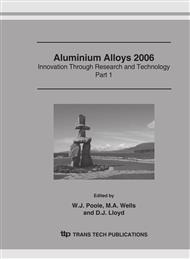[1]
M. Rappaz, Ch, -A. Gandin, A. Jacot, Ch. Charbon, in: Modeling of Casting, Welding and Advanced Solidification Processing VII, edited by M. Cross and J. Campbell (1995), p.501.
Google Scholar
[2]
Q. Li, D. Li, B. Qian: Intl J of Cast Metals Research Vol. 17 (2004), p.339.
Google Scholar
[3]
J. Campbell: Castings, 2nd Edition - The New Metallurgy of Cast Metals (Elsevier, UK 2003).
Google Scholar
[4]
J. Campbell, in: Shape Casting: The John Campbell Symposium, edited by M. Tiryakioğlu, P.N. Crepeau, TMS (2005), p.3.
Google Scholar
[5]
J. Mi, R.A. Harding, J. Campbell: Intl J of Cast Metals Research Vol. 14 (2002), p.325.
Google Scholar
[6]
M. Wierzbinska, J. Sieniawski: Intl J of Cast Metals Research Vol. 17 (2003), p.267.
Google Scholar
[7]
N.R.G. Mountford, R. Calvert: J Inst Metals Vol. 88 (1959-60), p.121.
Google Scholar
[8]
T. Grab, L. Arnberg: Intl J Cast Metals Research (2006), in press.
Google Scholar
[9]
J. L. Walker, in: The Physical Chemistry of Process Metallurgy Part 2 edited by G.R. StPierre, Interscience, New York (1959), p.845.
Google Scholar
[10]
D. Dispinar, J. Campbell: Intl J of Cast Metals Research Vol. 17 (2004), p.287.
Google Scholar
[11]
M.C. Flemings: Solidification Processing, McGraw-Hill (1974), p.134.
Google Scholar
[12]
E.W. Miguelucci: Trans AFS Vol. 93 (1985), p.913.
Google Scholar
[13]
J. Gurland, in: Proceedings of the 2 nd Conf. on Strength of Metals and Alloys (1979), p.621.
Google Scholar
[14]
J Campbell: Mater Sci Techn (2006), in press.
Google Scholar
[15]
M. Tiryakioğlu, in course of publication.
Google Scholar
[16]
E.J. Gumbel: Statistics of Extremes Columbia University Press (1958).
Google Scholar
[17]
M. Tiryakioğlu, unpublished research.
Google Scholar
[18]
J. Yi, Ph.D. Thesis, Imperial College, University of London, (2004).
Google Scholar
[19]
Q.G. Wang, D. Apelian, D.A. Lados: J of Light Metals Vol. 1 (2001) p.73.
Google Scholar
[20]
J Campbell, in: Simulation of Aluminum Shape Casting Processing, edited by Q.G. Wang, M.J.M. Krane, P.D. Lee, TMS, (2006).
Google Scholar


